
American Autochrome
“When the World Turned to Color ” — 20th exhibition of Šechtl & Voseček Museum of Photography.
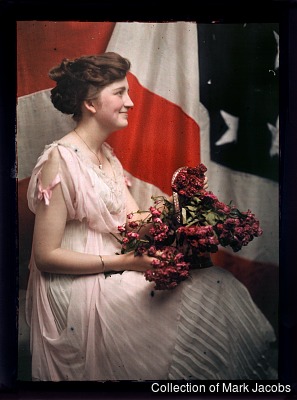
-
Woman with U. S. Flag.
Photographer Unknown
Autochrome 18 × 13 cm,
Owner of the original autochrome: Collection of Mark Jacobs All rights reserved, use of the digital reproduction is possible only with written permission from the owner of photographThe woman is posed in front of the American flag which serves as a backdrop to this delightful Autochrome. Black and white images featuring the American flag were a stable of life during the patriotic fervour which swept the nation during the period of the World War I. Autochromes with American flags are, however, scarce. This large Autochrome was presented in a diascope, a special device which allowed one to view the image with the use of a mirror and reflected light.
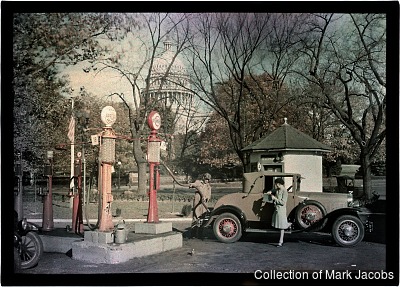
-
Gas Station, Washington D. C.
Edwin L. Wisherd (–)
Autochrome 18 × 13 cm,
Owner of the original autochrome: Collection of Mark Jacobs All rights reserved, use of the digital reproduction is possible only with written permission from the owner of photographWisherd came to the National Geographic as nineteen – year – old assistant to their single – member photographic department, thus becoming one of the magazine’s earliest staff photographers. Prior to that time nearly all the Autochromes featured in the magazine were the work of freelancers such as Fred Payne Clatworthy. After he became chief of the photographic lab in 1936, Wisherd equipped all the photographers with the then novel 35 mm camera loaded with color film which was to quickly replace both the Autochrome and its competitors. This plate is a slight variant of the image which appeared in the Corcoran Gallery of Art exhibition in Washington D.C. celebrating the National Geographic Society’s centennial in 1988.
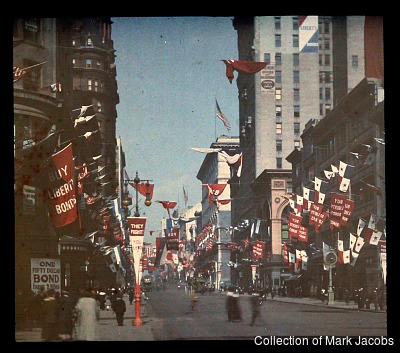
-
War Bond Rally, New York City.
J. D. Willis (–)
Autochrome 3 ¼ × 4 ¼ inches,
Owner of the original autochrome: Collection of Mark Jacobs All rights reserved, use of the digital reproduction is possible only with written permission from the owner of photographAutochromes were occasionally used to record scenes related to news events, although newspapers and most magazines could not print them in color. In addition, the relatively low sensitivity of Autochrome plates meant that fast-moving events would register as little more than a blur.
Even so, images like this one by J. D. Willis of Flushing, New York, provide some insight into the news of the time. Surprisingly, Autochromes of New York City are extremely rare with less than two dozen currently known to exist.The size of this Autochrome indicates it was a lantern slide—an image intended for projection onto a screen.
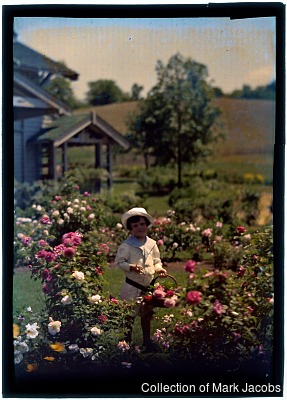
-
Portrait of a Child.
Arnold Genthe (–)
Autochrome 5 × 7 inches,
Owner of the original autochrome: Collection of Mark Jacobs All rights reserved, use of the digital reproduction is possible only with written permission from the owner of photographBorn in Germany to a family of scholars, Genthe was a recent Ph.D. in classical philology when he came to the United States in 1895 to work for two years as a tutor. On his days off, he walked the streets of Chinatown in San Francisco, where he began to photograph. These images were published in the 1909 book Pictures of Old Chinatown. In 1911 he moved to New York, where he continued to work as a successful portrait and pioneering dance photographer. Genthe was an early adopter of the autochrome. His subjects included portraits, artistic nudes, and landscapes.
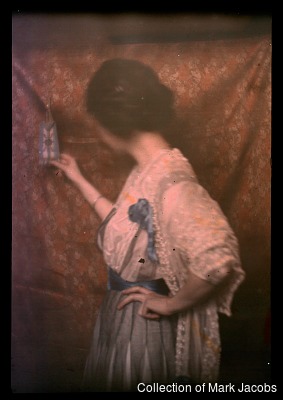
-
Portrait.
Paul Burty Haviland (–)
Autochrome 7 × 5 inches,
Owner of the original autochrome: Collection of Mark Jacobs All rights reserved, use of the digital reproduction is possible only with written permission from the owner of photographHaviland’s family owned Haviland & Co., a well-known china manufacturer in Limoges, France. In early 1908 he and his brother Frank, who was a photographer, went to see the exhibition of Rodin drawings at the Little Galleries of the Photo-Secession, where he met Alfred Stieglitz. Both he and his brother bought works from the exhibit, and soon he and Stieglitz were engaged in long discussions about art and culture. Haviland considered the gallery “a unique oasis of cultivation” and soon spent most of his time there. Eventually, Haviland signed a three-year lease for Stieglitz to retain the Little Galleries. Though the subject of this image is not identified, it is thought to be a portrait of the photographer Anne Brigman. There are only six known Autochromes by Haviland.